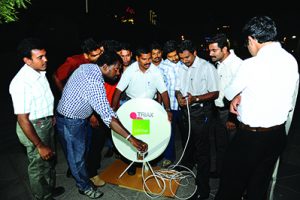
The journey from a zero-customer base in 2015 to more than 10m Maghreb households in just two years in the face of entrenched competition is nothing short of phenomenal. According to SES’ annual market research, Satellite Monitor, Yahlive at 52.5° East now serves 64% of households in Algeria, 51% of households in Tunisia, and 58% of households in Morocco.
Yahlive’s Chief Operating Officer, Ammar Baranbo, attributes the exponential growth to one word: communities. He presented a detailed report of the survey at the recently concluded Arab States Broadcasting Union’s Radio and TV Festival held in Tunis.
Speaking to SatellitePro ME on his return, he elaborates: “Yahlive is in the business of serving communities, generally defined as a social grouping that shares common norms, values, identity, and often a sense of place that is situated in a given geographical area. This central mission permeates everything we at Yahlive do; from establishing partnerships with broadcasters to communicating with viewers and understanding their requirements and preferences. Similarly, in North Africa – also known as the Arabian Maghreb – we targeted communities by bringing them the content they want.
“FTA DTH is the most prominent platform across all three countries, and the countries share the same interest in languages and content including French language content and sports.”
Yahlive launched its first bouquet of Arabian Maghreb channels in November 2015, with 43 Algerian channels. Today, Yahlive serves this community with more than 160 Arabic and French channels, of which 115 are only available on Yahlive.
The focus on sports, movies and news, combined with image quality offered by Yahsat’s Al Yah 1 satellite, makes Yahlive a compelling proposition for its customers and viewers, Baranbo claims. “One of the reasons we focused on these three countries since 2015 is the relatively large populations that is significantly young and is eager for new content. Most importantly, 97% of that content comes through satellite.”
Recounting Yahlive’s growth trajectory since inception, Baranbo says: “Yahlive launched its broadcasting services in 2011. Today, Yahlive broadcasts more than 400 TV and radio channels to more than 26m households across Southwest Asia and MENA, targeting various culturally diverse communities. The numbers –which have been concluded by global reputable research companies – speak for themselves.
“In the Farsi market, the number of dishes pointing to 52.5˚ East have been exponentially growing year after year from 6m households by the end of 2014, to more than 16m households by the end of 2017 – according to IPSOS Connect – with a market share of 45% of the Farsi speaking community living in Iran, Afghanistan, GCC, and Tajikistan. The same strategy was applied in the Arabian Maghreb, by which Yahlive signed its first agreement with 43 TV channels in November 2015. By the end of 2017, according to global market research and information group Kantar TNS, Yahlive had a reach of more than 10m households across Tunisia, Algeria, and Morocco, with more than 100 channels.”
Elaborating on the region, Baranbo states: “The Arabian Maghreb TV market continues to expand and satellite remains the first choice for viewers. The Arabian Maghreb – specifically Tunisia, Morocco, and Algeria – has a population of over 85m, of which 97% are satellite homes. Out of those, there are more than 8m HDTV homes, with Algeria having the highest penetrations of the three countries. Advertising expenditure is also very high according to media agencies, with TV accounting for more than 40%. Morocco is the largest advertising marketing in North Africa, followed by Algeria.”
The Maghreb especially Tunisia, Algeria and Morrocco, has been a fertile ground for satellite television since early 2000. With a restless youthful population looking for content beyond what the state channels offered, there was what one expert described an “international stampede to the video marketplace of ideas” in the Maghreb and larger Arab world. While selling capacity for a satellite operator over the Maghreb may not have been a big challenge, creating stickiness with viewers would have been an uphill battle.
Baranbo credits three factors that aided Yahlive’s growth in the region. “The bouquet we created there, the strategy, and the on-ground partnerships — all of these resulted in the successful penetration of the market. We were keen to have exclusive channels on our satellite not offered anywhere else. Moreover, we complimented our bouquet with channels or a group of channels that were not from the Maghreb, but top rated globally and highly requested by our viewers. In that sense we kept our offering unique.”
In 2016, in addition to the 57 channels on the bouquet, Yahlive offered a line-up of entertainment and local channels as well as international channels including France 24, BBC Arabic, Abu Dhabi TV, Abu Dhabi Drama, Abu Dhabi Sports 1 & 2, National Geographic Abu Dhabi and Fashion 4K.
Describing the chain of partners and local partners as intricate and vital to their success, he says: “Our strategy across all our markets is to work with local partners who understand the market needs and requirements to better serve our customers and the viewers in each community. “We work closely with our local partners creating targeted TV channel offerings for our viewers. It is not just about signing contracts and leaving them. We support them and facilitate their work through marketing and training for local dish installers. During our training sessions we sense a huge amount of interest from the installers who are on the ground selling satellite dishes because they see potential in the content we offer, which in turn increases their sales.”
With Eutelsat in the region since 1967 followed by Nilesat, Arabsat and Noorsat, it would be fair to say Yahlive was joining a crowded field in 2015.

On the strategies deployed to stand out from the crowd, Baranbo says: “Social media usage in the Arabian Maghreb is very high with more than 90% of the population using Facebook and WhatsApp. Hence, in addition to TV advertising, PR and installer workshops, we are extremely active on social media and use this platform as a means to engage directly with our viewers in the region. In March 2018, we launched a mini survey by collecting a sample of 800 viewers to enquire about Yahlive viewership in support of the Kantar TNS study. More than 50% responded saying that they watch Yahlive. Additionally, we were able, through such surveys, to better understand our target audience and bring them the channels they want.”
Technology, according to Baranbo, is ultimately at the heart of the Yahlive experience. Yahlive, headquartered in Abu Dhabi in the United Arab Emirates, was launched in 2011 as a joint venture between global satellite operator SES and Yahsat, a UAE-based satellite operator. Yahlive provides its capacity via Yahsat’s Al Yah 1 satellite, which provides a powerful signal, using a small dish and uninterrupted reception, which makes it high quality at an affordable price. The association with SES has enabled Yahlive to drive new technology in the region including launching in 2016 its first free-to-air 4K channel, Fashion One 4K, in the MENA region.
Baranbo elaborates: “We don’t just sell capacity. Our services range from uplink to playout, in addition to many more, and are provided when needed to support our customers.
On the future looming with the prospects of better fiber connectivity in these countries and the impending arrival of 5G, Baranbo sounds optimistic.
“I do not see these developments as a threat to our services. We are already aligning ourselves and creating new synergies with the new technologies and we see ourselves complementing other services, not competing,” he says.
Baranbo’s team is now looking to replicate the Maghreb and Farsi success elsewhere with the continued focus on targeted viewing communities.
We are looking at enhancing our offerings in the communities that we service as well as looking at other communities within the reach of our coverage areas.
Going forward in the Maghreb, Baranbo believes the market will only expand given the appetite for new content.
On what has surprised him most about their presence in Algeria, Tunisia and Morocco, Baranbo says: “What has surprised me is the immense potential these countries have, the adaptability to new offerings and the awareness and passion for the broadcast industry. For example, any channel additions or drops we have, we immediately see high engagement on social media.”
The journey to achieving considerable market share in the Maghreb was not easy, Baranbo admits. “We were patient and were always present on the ground studying the channels that had appeal, monitoring the market and following up with our partners.”












Add Comment